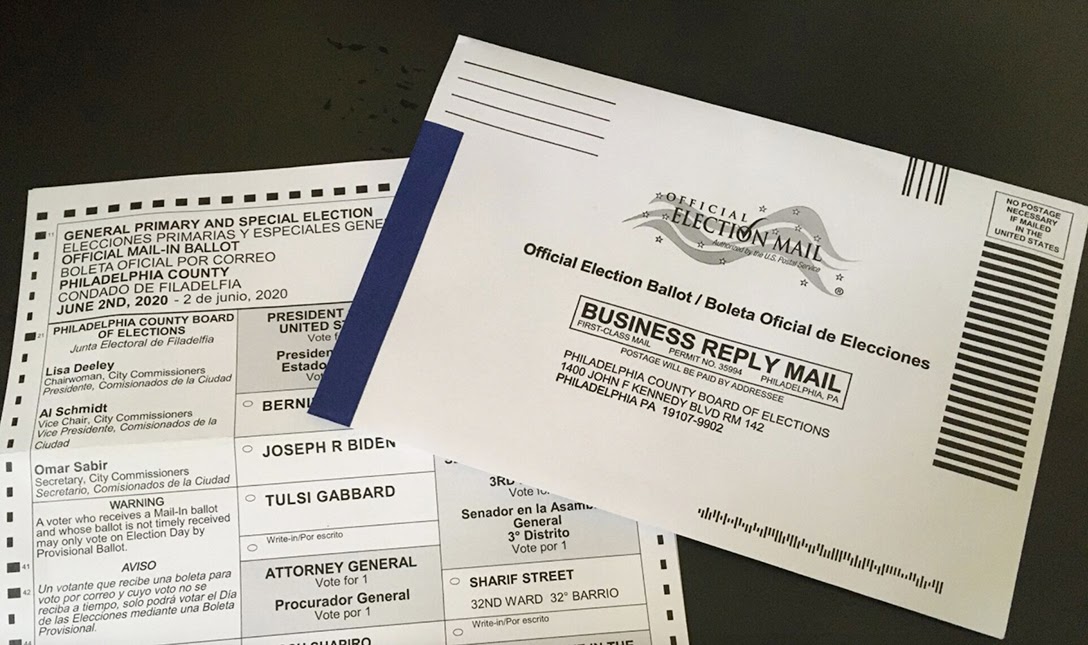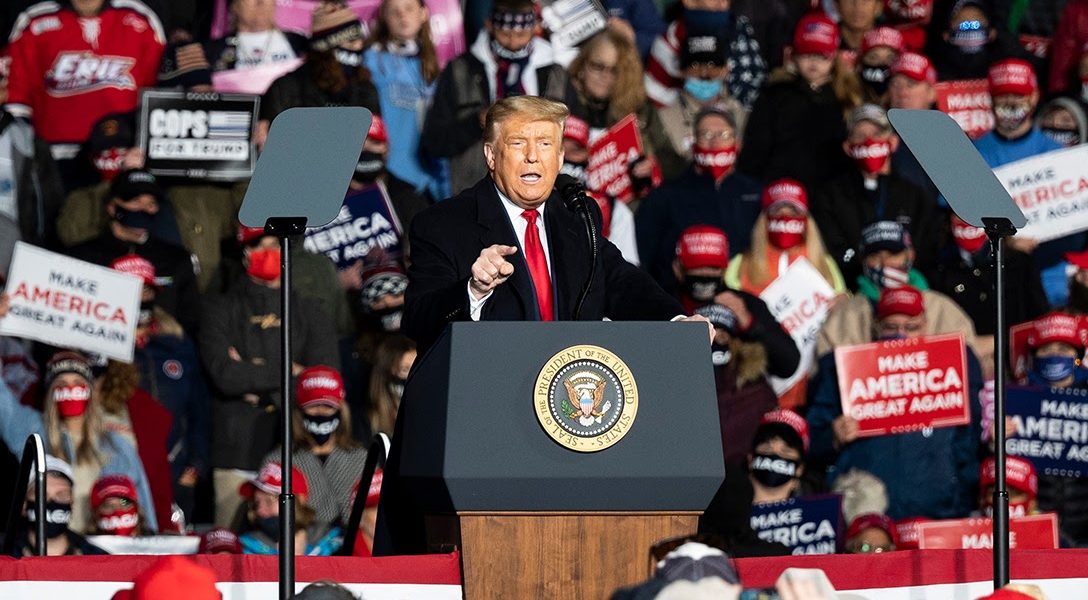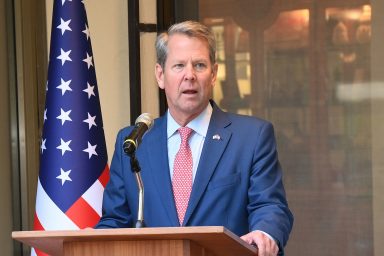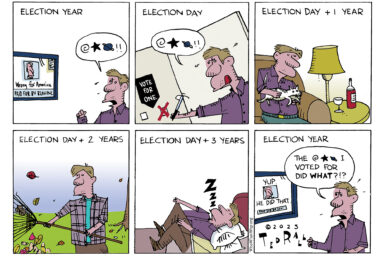With Trump down in the polls, Pennsylvania Republicans turn to the courts as a last resort.
It’s raining lawsuits in Pennsylvania as Election Day approaches. Pennsylvania is a state that President Trump narrowly won in 2016, and it remains on his “must win” list again this year.
The suits have been filed by the Trump campaign or Trump surrogates to set up roadblocks to voting or to set the table for legal and political challenges to election results if, as expected, the president loses to Democrat Joe Biden in the state in the November 3 election.
All of the suits and political rhetoric allege the election will be tainted because of widespread voter fraud, a familiar trope of the president’s.
For the most part, the courts are rejecting the suits. The latest to do so was the US Supreme Court, which refused, in a ruling Monday (October 19), to overturn a state court decision that allowed mail-in ballots postmarked on Election Day to be counted if they arrive within three days of the election.
The vote was 4-4, with the conservative judges lining up against the extension and the court’s three liberal judges — joined by Chief Justice John Roberts — voting to allow the additional time.
Under court rules, an appeal fails if there is a tie vote. The ruling led to speculation over the outcome if Amy Coney Barrett, the president’s nominee to fill the vacancy left by the death of Justice Ruth Bader Ginsburg, had been on the court and heard the case.
Republicans said they intend to bring the case back to the high court once Barrett is confirmed by the Senate, though the case would have to be reheard after the election.
The courts are not the only venue for this pro-Trump offensive. The state Legislature, which is controlled by the Republicans, joined the fray this week simply by doing what it does best: nothing.
The approaching tsunami of mail ballots has induced low-level hysteria among election officials in the state’s 67 counties that will have to process and count paper ballots that number in the thousands — and sometimes in the hundreds of thousands.
The target was a new state law that allows mail-in voting. Previously, absentee ballots were only allowed if the voter could say that he or she would be out of town or was too ill to vote in person. The state usually had 10,000 to 20,000 absentee ballots cast each election.
This year, with a “no excuse needed” law in effect, state election offices have been inundated with mail-in ballots, nearly 3 million at last count. But, while the Legislature opened the flood gates to mail-in ballots, it failed to make any major changes to the deadline for counting them. Mailed ballots cannot be opened — cannot be touched, really — until 8 a.m. on Election Day.
The approaching tsunami of mail ballots has induced low-level hysteria among election officials in the state’s 67 counties that will have to process and count paper ballots numbering in the thousands — and sometimes in the hundreds of thousands.
“In our county, we have over 22,000 registered voters and we are fast approaching 5,000 mail-in ballots,” said Jeff Snyder, a Republican county commissioner in Clinton County in north central Pennsylvania. “It is going to take time because we cannot open them and scan them and process them until the morning of Election Day.”
Snyder is president of the state’s County Commissioners Association, and the PCCA turned to the state Legislature for help, seeking passage of a bill that would allow local election officials to begin processing mail ballots as of 8 a.m. on the Saturday before the election. Note: the word is process, not count.
The early processing of mail ballots, which is called “pre-canvassing,” would only allow election officials to open the outer and inner envelopes, remove the folded ballots inside, and set them in a flat stack to be fed into a high-speed scanner on Election Day. The scanner will read the ballots, total the votes, and store the results on a USB stick.
The state House and Senate, which both have Republican majorities, had only a short window of time to act because both chambers planned to adjourn on Wednesday until after the election.
https://www.youtube.com/watch?v=cVrccbriFEY
To the bafflement of some and consternation of many, the House and Senate left town without acting on the proposal.
When asked why the Republican legislative leaders failed to act, Snyder replied, “I have not had an explanation. I can’t give you a reason why. Quite frankly, I don’t understand why. They clearly understood the volume of ballots.”
The Committee of Seventy, a well-regarded election integrity group based in Pennsylvania, had written to each legislator backing this bipartisan request for help by local government officials.
“It’s really frustrating, a shame and almost a dereliction of duties,” said David Thornburgh, the head of the committee. “And the county commissioners were on their knees, Republican and Democrat. They just wanted time to do their job.”
Snyder and Thornburgh declined to speculate on why the Legislature left town without acting, but a significantly delayed result will feed into the narrative being pushed by President Trump: that mail-in ballots promote voter fraud and will result in a “rigged” election.
A long count can lead to fears of tampering with the vote and also result in a rash of postelection lawsuits, along the lines of the contested election in Florida in the 2000 presidential race.
“Do you remember Florida and the hanging chads?” said Rep. Don Moul, a Republican House member from Gettysburg. “We could have lawsuits in county after county, same as Florida.”
Tick-Tock — How ‘60 Minutes’ Sat on a Crucial 2000 Election Story
Moul is the author of the bill to allow pre-canvassing, and he is a believer that the electoral system is ripe for fraud.
But he and other Republicans are having a hard time convincing the courts that voter fraud is a clear and present danger.
Pennsylvania is a partisan’s paradise, with the two major parties dueling fiercely over most major issues. The Republicans control the legislative branch, but the governor’s office is headed by Democrat Tom Wolf. The state Supreme Court has seven Democrats and only two Republicans. All justices are elected in statewide contests, which favor the Democratic big cities of Philadelphia and Pittsburgh.
On September 17, the state high court issued a multi-pronged opinion that, Republicans charge, almost uniformly favored the Democratic effort to encourage mail-in ballots.
“That court is bought and paid for by the unions,” complained Moul. “Those guys are corrupt.”
But, it’s not only dyed-in-the-wool Democrats ruling against election restrictions. On October 10, a federal judge in Pittsburgh — who was appointed to the bench by President Trump — ruled against a suit filed by the Trump campaign, which wanted to limit the number of drop boxes where people can turn in their mail ballots without using the US Postal Service.
The campaign also asked the judge to allow county election officials to disqualify mail-in ballots where the voter’s signature may not match their signature on file in the election books. Finally, it wanted to remove a requirement in state law that forbids certified poll watchers to monitor voting in counties where they do not live.
Philadelphia election officials feared that the Trump campaign would flood the city with out-of-town poll watchers who would seek to intimidate voters or gum up the voting process.

In his ruling, US District Judge J. Nicholas Ranjan wrote that the Trump campaign made these requests in the name of preventing voter fraud, but offered no evidence that the president has been or would be hurt by fraud. In other words, he rejected the idea that fraudsters were coming to get Trump.
As Ranjan wrote: “While plaintiffs may not need to prove actual voter fraud, they must prove that such fraud is ‘certainly impending.’ They haven’t met that burden. At most, they have pieced together a sequence of uncertain assumptions.”
Democrats in particular have embraced the notion of voting by mail. Sixty-four percent of the 2.9 million mail-in ballots requests have come from Democratic voters. Mail ballot requests from Republican counties have lagged far behind, at 25 percent statewide.
Most Republicans intend to vote in person, and that means the results could be tilted towards Trump on election night, allowing him to claim victory in the state and setting the stage for another round of challenges to mail-in results.
“It’s worth knowing that we will likely see litigation regardless of the outcome or how smoothly everything runs,” said Suzanne Almeida, a lawyer with Common Cause in Pennsylvania.
During the primary election, when the state handled 1.5 million mail-in ballots, it took many counties four or five days to process and count them; it took two weeks in some of the state’s largest counties.
Since then, the state has offered grants to counties to buy high-speed scanners (at a cost of $5,000 each), hire additional help for the vote count, and, at least, replace old, hand-held letter openers with quicker electric ones.
When asked how many scanners Clinton County had, Snyder at first said, “Two,” then added, “Better check that with our election clerk; she’s right down the hall.”
He returned to the phone a few minutes later and said, “I was wrong. We have three scanners we will use and a fourth we will hold in reserve. I’m told it takes two seconds for each ballot to be counted.”
While Clinton County may have 5,000 mail-in ballots to count, Philadelphia is likely to have close to 500,000: A nightmare come to life.
Election officials have responded by moving the operation for counting mail ballots to the city’s cavernous convention center, hiring a legion of workers to help in the count, and investing heavily in equipment not only to scan ballots, but also to open and sort them.
These investments were made possible by a $10 million grant made in August by the Center for Tech and Civic Life, a nonprofit funded by a $350 million grant from Facebook founder and CEO Mark Zuckerberg and his wife, Priscilla Chan.
The legality of those grants was challenged last month in the courts in a suit that names 10 US cities, including Philadelphia, alleging that the Center for Tech and Civic Life is not nonpartisan and is targeting liberal, Democratic cities for its grants. The suit was filed by the Amistad Project of the Thomas More Society, a conservative, anti-abortion legal group.
Much of the anti-mail efforts have focused on Philadelphia, a deep-blue city with more than 1 million voters, likely to support Biden by a margin of 80 percent or higher. As Trump has said: “Bad things happen in Philadelphia.” They certainly do happen to him.
As if on cue, city election officials this week shooed away a cameraman who turned up at ballot drop-off sites and filmed voters putting two or three ballots in the boxes. The cameraman worked for the Trump campaign; this led Linda A. Kerns, a local lawyer for the campaign, to declare the activity was “the just tip of the iceberg” of voter fraud and would continue with impunity unless stopped.
“Harvesting” votes, the collecting and dropping off of hundreds of ballots, is illegal. But those voters, election officials said, may have been dropping off the ballots of spouses or relatives not able to make the trip to the balloting site. Election officials did not express alarm at the practice filmed by the Trump campaign.
In the meantime, the city is set to do a rapid count of the mail ballots beginning the morning of Election Day. Kevin Feeley, a spokesperson for Philadelphia election officials, said that the plan was to have all mail-in ballots counted within a few days of the election.
In reality, despite the fears of vote fraud, technology has changed mail ballot counting from a slow process done by hand — and thus subject to human tampering — to a highly automated process done in the blink of an eye. Machines do malfunction and they do break down, but they do not cheat.
Losing lawsuits and being rebuffed at attempts to monitor the polls may be beside the point for the Trump campaign. Those preelection actions may be priming the pump for postelection antics.
The “uncertain assumptions” cited by Ranjan could morph into assertions by the Trump campaign after Election Day that voter fraud was widespread and sabotaged the president’s chances of winning in this state.
If Trump cannot win Pennsylvania on November 3 by going through the front door and defeating Biden, his supporters seem willing to go around to the back door and make the postelection period a legal and political hell, eventually making their way to the US Supreme Court, where new Justice Barrett and her conservative brethren await.
Marco Cerino and Brendan Foster contributed to the reporting of this story.
—
For more of WhoWhatWhy’s work on Protecting Our Vote, see our Student Voter Guide and our series America Decides 2020. You can also find out the darker secrets behind our voting systems in our recently published e-book Is This Any Way to Vote?: Vulnerable Voting Machines and the Mysterious Industry Behind Them by Celeste Katz Marston and Gabriella Novello, available on Amazon now.
Related front page panorama photo credit: Adapted by WhoWhatWhy from PBS NewsHour / Flickr (CC BY-NC 2.0) and Atavic Art / Flickr (CC BY-NC-SA 2.0).




